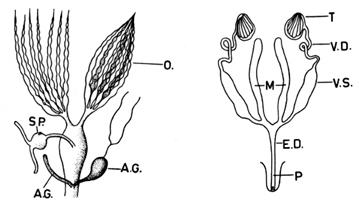| Reproduction |
 | |
| O. - ovarium S.P. - spermatheca A.G. - accesory gland | P. - penis T. - testis M. - mesodenia V.D. - vas deferens V.S. - vesicula seminalis E.D. - ejaculatory duct |
Insects, like many organisms, reproduce sexually.New insects hatch from fertilized insect eggs, which result from the mixing of thesperm of the maleinsect with the egg of the female insect. Thefemale insect produces the eggs, in a processcalled oögenisis. Oöogenisis takes place in the twoovaries, which may contain up to 2000eggs each. Each ovarie consists of many tubules,which contain the undeveloped eggs. As anegg matures, it travels the length of thetube, and is eventually released into the oviduct.By this time it has developed fully, and it contains a layer ofnutrative cells which provide it with food. The female insect also hasaccesory glands which produce adhesive matrial which eventually serves to protectthe eggs. The male insect producessperm through the process ofspermatogenesis. The sperm is produced in densly packed tubulse in thetestes. The sperm is storedin the vesicula semialis(seminal vesicle) until it is realeased.The male insect transfers the spermto the female insect in seminal fluid whichcontains special sperm capsules, called spermatophores, which contain the actual sperm.
|
|